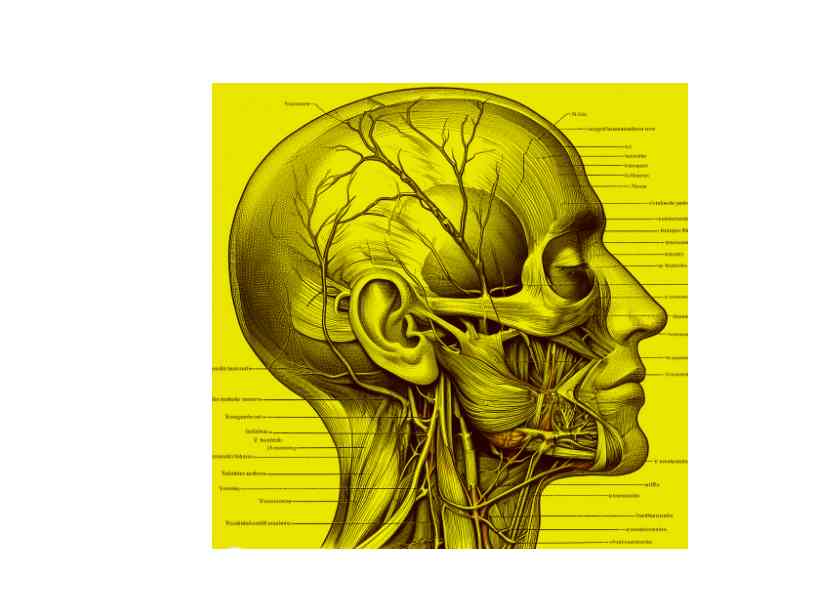Quick Overview
The marginal mandibular nerve (MMN) is a terminal branch of the facial nerve (CN VII) and responsible for innervating the muscles of the lower face and lower lip, including the risorius, depressor anguli oris, depressor labii inferioris, and mentalis muscles. These muscles are responsible for facial symmetry and expressions such as smiling, frowning, and pouting.

Table of Contents
Anatomy and Location
The MMN arises from the facial nerve in the parotid gland and exits the gland at its anteroinferior border. It then runs forward and superficially to the facial artery and vein, crossing the inferior border of the mandible about 1 cm below the angle of the mandible. The MMN then turns upwards and splits into several branches that supply the muscles of the lower face and lower lip.
| Nerve | Description |
| Origin | Facial Nerve |
| Branches | Risorius, Depressor anguli oris, Depressor labii inferioris, Mentalis |
| Supply | risorius muscle, depressor anguli oris muscle, depressor labii inferioris muscle, mentalis muscle |
Function of Marginal Mandibular Nerve
The MMN is responsible for motor innervation of the following muscles:
- Risorius muscle: It Pulls the angle of the mouth laterally
- Depressor anguli oris muscle: Pulls the angle of the mouth downwards
- Depressor labii inferioris muscle: Pulls the lower lip downwards
- Mentalis muscle: Raises the chin and protrudes the lower lip
These muscles are responsible for facial symmetry and expressions such as smiling, frowning, and pouting.
Branches and Supply
The MMN splits into several branches as it courses across the face;
1- Risorius branch: It supplies the risorius muscle
2- Depressor anguli oris branch: Supplies the depressor anguli oris muscle
3- Depressor labii inferioris branch: Supplies the depressor labii inferioris muscle
4- Mentalis branch: Supplies the mentalis muscle
Clinical Importance
The MMN is at risk of injury during surgery in the submandibular region, such as submandibular gland excision or neck dissection. Damage to the MMN can result in facial asymmetry and weakness of the muscles of the lower face and lower lip. This can make it difficult to smile, frown, and pout.
Associated Conditions
Several conditions and factors can affect this nerve;
- Trauma: Traumatic injuries to the neck and lower face can damage the nerve, leading to functional impairments.
- Neoplasms: Tumors or growths in the parotid gland or surrounding structures may compress or invade the mandibular nerve.
- Surgical Complications: As mentioned earlier, surgical procedures in the neck and lower face carry a risk of nerve injury, especially if not performed with precision.
- Inflammatory Conditions: Inflammatory diseases, such as Bell’s palsy, can affect the facial nerve system, including this nerve, leading to temporary or permanent facial weakness.
- Infections: Infections or abscesses in the neck region may also put pressure on or damage the nerve.
Question
1. What is Marginal Mandibular Nerve Injury?
Marginal Mandibular Nerve Injury refers to damage or trauma to the marginal mandibular nerve, a branch of the facial nerve. This injury can lead to functional deficits in the lower lip and chin muscles, affecting facial expressions and various functions like speaking and eating.
2. What is the Marginal Mandibular Nerve Danger Zone?
It is the area in the neck where the marginal mandibular nerve descends vertically. It’s called a “danger zone” because it’s susceptible to injury during surgical procedures in the neck and lower face.
3. Can Marginal Mandibular Nerve Injury Occur After a Facelift?
Yes, nerve Injury can occur after facelift surgeries. Surgeons must be cautious during these procedures to avoid damaging the nerve, as injury can result in an asymmetrical smile and other facial issues.
4. Is Recovery Possible After Marginal Mandibular Nerve Injury?
Yes, recovery is possible after nerve Injury, but it depends on the extent of the injury. Some cases may resolve spontaneously, while others may require rehabilitation, surgical intervention, or other treatments to regain function.
5. What is Marginal Mandibular Nerve Palsy?
Marginal Mandibular Nerve Palsy refers to the paralysis or weakness of the muscles controlled by the marginal mandibular nerve. This condition can result from nerve damage, inflammation, or other underlying causes.
6. What is the Course of the Marginal Mandibular Nerve?
The Marginal Mandibular Nerve originates from the facial nerve in the parotid gland and descends vertically into the neck, supplying muscles of the lower lip and chin.
7. Are There Exercises for Marginal Mandibular Nerve Injury Rehabilitation?
Yes, there are exercises and rehabilitation techniques that can help in the recovery of Marginal Mandibular Nerve Injury. These exercises are typically prescribed by healthcare professionals and aim to strengthen and retrain the affected muscles, facilitating functional recovery.
